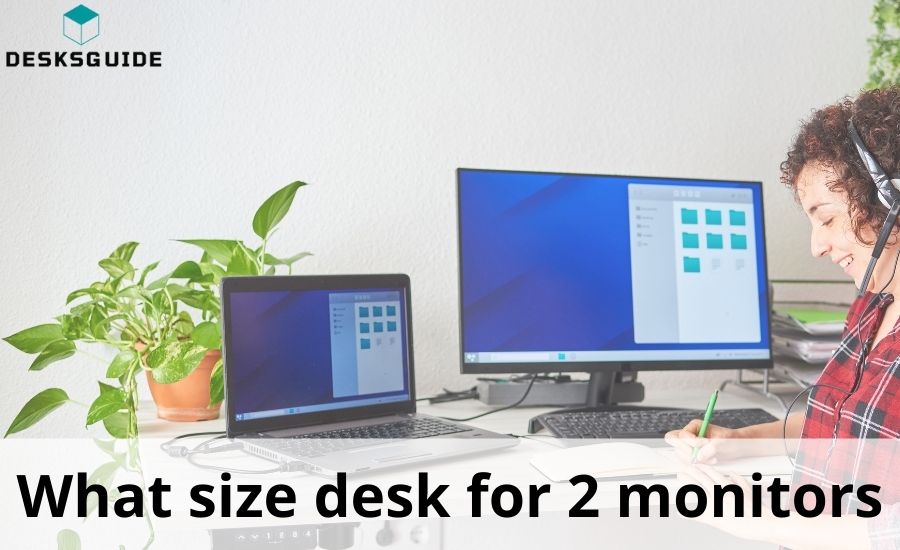Setting up a comfortable workstation is essential for productivity, especially in today’s digital age. However, determining the appropriate desk size for accommodating two monitors can be a daunting task.
Dual monitors have become increasingly popular among professionals, gamers, and multimedia enthusiasts, as they provide a broader visual workspace and enhance multitasking capabilities. However, to fully maximize the benefits of dual monitors, it is important to consider the appropriate desk size.
In this article, we will explore various factors to consider what size desk for 2 monitors you need.
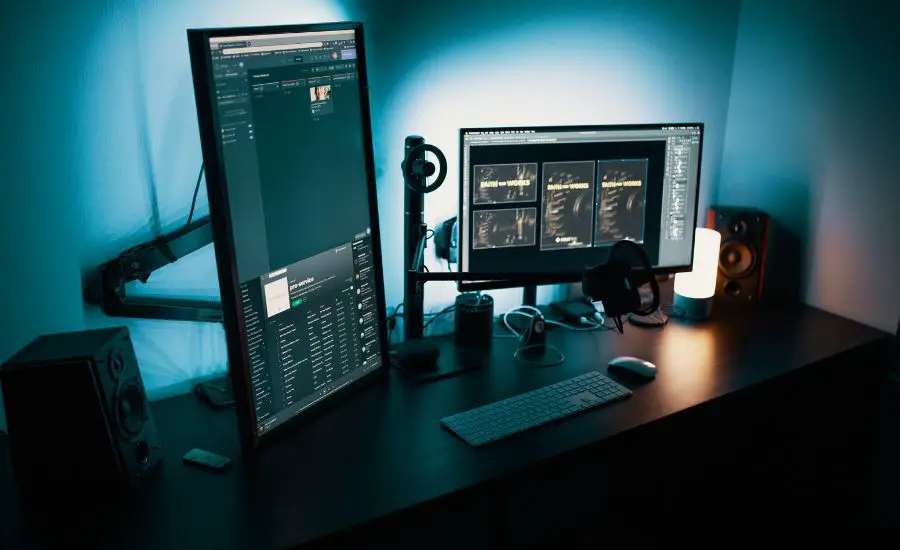
The size of the desk
Based on the considerations, mentioned below, for a dual-monitor setup, a desk width of 50 to 60 inches (127 to 152 cm) is generally recommended. This allows for the comfortable placement of both monitors side by side, along with space for peripherals. Keep in mind that these measurements are approximate and can vary based on individual preferences and needs.
There are some aspects you should pay attention to while choosing a desk for your monitors.
Depth
In addition to width, consider the depth of the desk to fit dual monitors.
Dual monitors not only require horizontal space but also some depth to accommodate the monitors’ size and allow for proper viewing angles.
Measure the depth of your monitors and consider any additional space needed for accessories like a keyboard, mouse, or other peripherals. Aim for a desk with a depth of at least 24 inches (60 cm) to provide enough room for your monitors and create a comfortable working distance.
Monitor size
The size of your monitors is a significant factor to consider when determining the appropriate desk size.
Multiple monitors come in various sizes, such as 24 inches, 27 inches, or even larger. Measure the width of each monitor to understand the total space they will occupy side by side.

Viewing distance
Consider the recommended viewing distance for your monitors.
Maintaining an appropriate distance is crucial to prevent eye strain and ensure optimal viewing angles. Measure the depth of your monitors and account for any additional space required for comfort.
Ergonomics
Ergonomics plays a vital role in creating a comfortable and healthy workspace. A small desk may result in the cramped positioning of multiple monitors, leading to discomfort in your neck and eyes.
Optimal ergonomics require more desk space to maintain a comfortable viewing distance and angle.
Available space
Consider the available space in the room or office where the desk will be placed.
Measure the area and ensure that the chosen desk size will fit dual monitors comfortably within the designated space.
Taking accurate measurements will help you avoid any surprises or space constraints.

Computer desk layout
The layout of your computer desk is another crucial factor to consider. Will two monitors be positioned side by side, or will one be placed above the other?
This will affect the desk size requirements, as a horizontal setup will require a wider desk, while a vertical setup will necessitate a small desk, but with sufficient height.
Additional equipment
Take into account any additional equipment you may need to accommodate on your desk, such as a keyboard, mouse, speakers, or a docking station.
These accessories will require additional space, so ensure that the desk size can accommodate all your essential peripherals comfortably.

Guidelines for selecting desk size
To determine the appropriate desk size for a dual monitor setup, start by considering the width required to accommodate both monitors comfortably.
Measure the width of each monitor, including any bezels or stands. Add these measurements together to determine the total width needed.
It’s important to choose a desk that provides ample space for both monitors side by side, allowing for comfortable viewing and efficient multitasking. Opting for a wider desk ensures you have enough desk space for other essential items and promotes better organization.
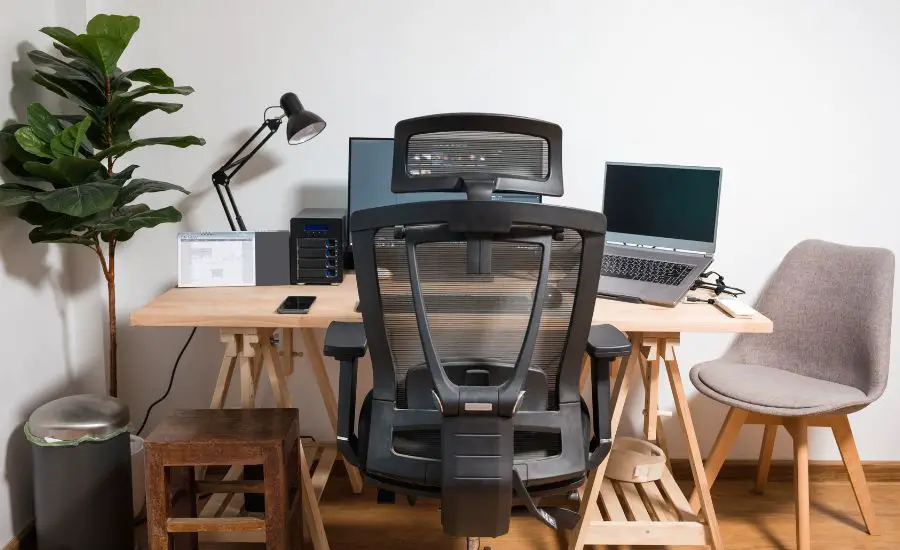
Shape
The shape of the desk can significantly impact your dual monitor. Rectangular or L-shaped desks are popular choices for accommodating multiple monitors.
They offer ample desk space, allowing you to position one monitor side by side with another one or create a corner setup.
If you have limited space, consider a corner desk to maximize the use of your available area while still providing enough room for your two-monitor setup.
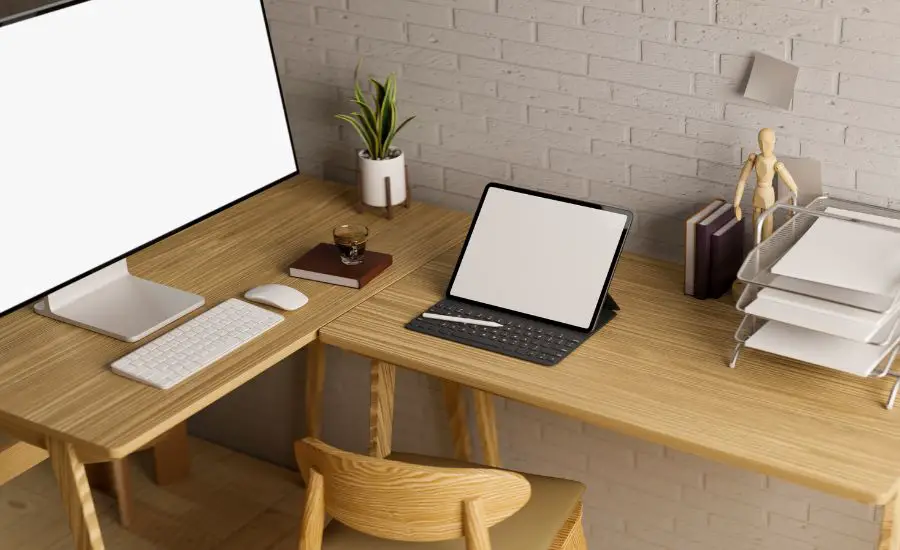
Adjustable features
Consider desks with adjustable features to enhance your dual setup further.
Adjustable standing desks are becoming increasingly popular as they provide flexibility in terms of height and allow you to switch between sitting and standing positions.
An adjustable desk can help you find the optimal viewing height and promote better ergonomics, reducing strain on your neck and eyes.
Additionally, using a monitor arm or a single raised monitor stand can free up desk space and provide more flexibility in positioning your monitors.

Cable management
Effective cable management is crucial for maintaining a clean and organized workspace. Look for desks that offer built-in cable management solutions, such as cable trays or grommets.
These features help keep your cables organized and prevent them from tangling or cluttering your desk space.
Tidy cable management not only improves the aesthetics of your dual monitor desk setup but also makes it easier to access and connect your devices.
Future expandability
If you anticipate adding more monitors to your configuration, it’s wise to choose a desk that provides sufficient space for growth.
This future-proofing ensures that you won’t outgrow your desk quickly and allows for easier upgrades or adjustments in the future.

Other desk options
Standing desks. These desks are an excellent choice for dual monitor setups, as they offer more space and the ability to adjust the height.
By utilizing a standing desk, you can find the perfect height for your monitors, reducing strain on your neck and improving overall comfort. Some standing desks even come with integrated monitor arms or stands, providing additional flexibility in positioning your screens.
Corner desks. If you’re working with limited space, consider that desk for your dual monitor stands. Corner desks are designed to fit into corners, making efficient use of space while still providing ample surface area.
This allows you to position your monitors ergonomically while leaving more space available for other items or workspace essentials.
Small desks. If you have a smaller workspace or limited available space, there are compact computer desks specifically designed for dual monitors.
These desks are designed to maximize desk space while still accommodating two monitors. Look for desks with a minimal footprint and consider using monitor arms or stands to save space.
Adjustable standing desks. An adjustable standing desk not only provides the benefits of standing while working but also allows you to customize the height of your monitors.
This feature is particularly useful if you prefer to position one monitor vertically, as it gives you the flexibility to adjust the height to your desired level.
That typical space-saving monitor can also accommodate different user heights and preferences, ensuring a comfortable and personalized multi-monitor setup.
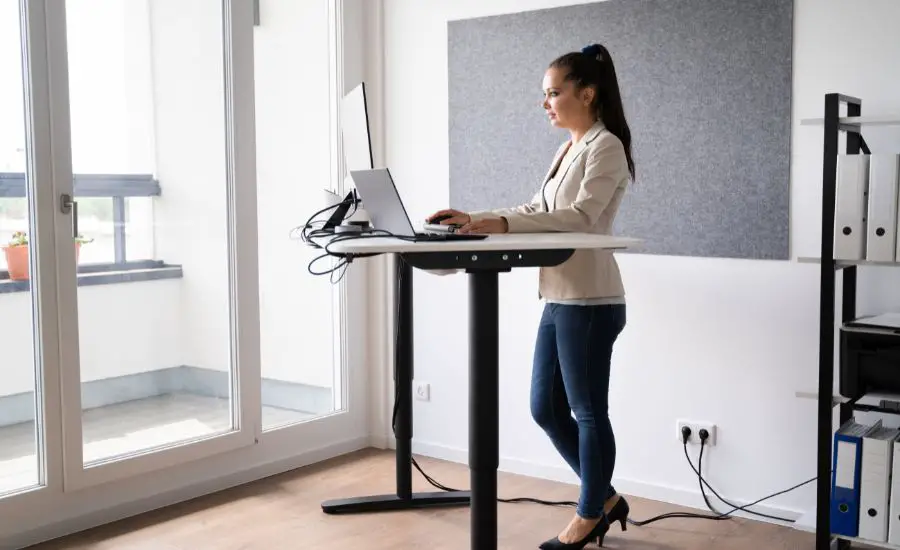
Desk height considerations
Standard desk height. The standard desk height is typically around 29-30 inches. This height works well for most individuals but may require adjustments based on personal preferences and the chair you use.
Ergonomic desk height. To achieve optimal ergonomics, ensure that your desk height allows your elbows to rest at a 90-degree angle while typing. Consider adjustable desks that allow you to customize the height according to your specific needs.
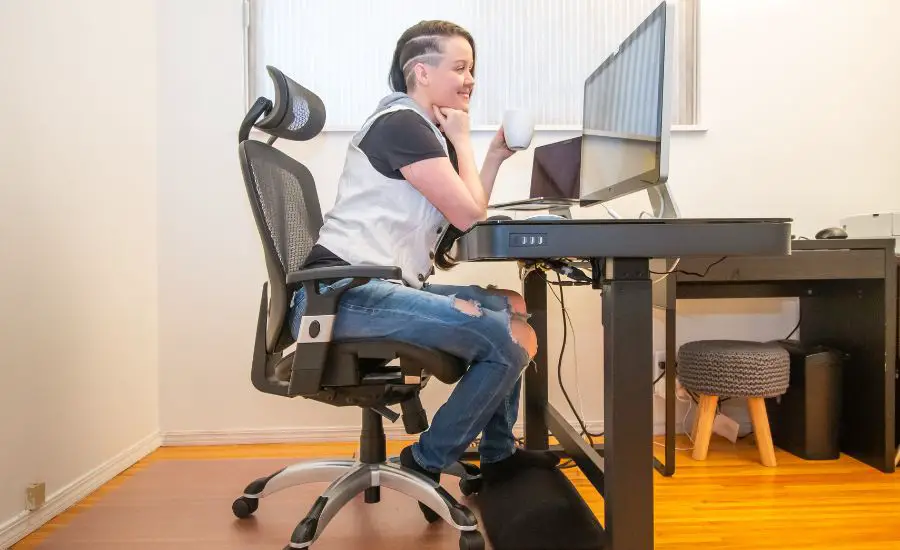
Practical tips for dual monitor setup
Cable management. Keep your workspace tidy by managing the cables. Use cable clips, zip ties, or cable sleeves to secure and route the cables neatly along the desk.
Monitor placement. Position the monitors at eye level to minimize strain on your neck and eyes. Consider using monitor stands or mounts to achieve the desired height and alignment.
Distance and angle. Maintain an arm’s length distance from the monitors, and position them at a slight inward angle to reduce glare and enhance visibility.
Organization and storage. A clean and organized desk promotes productivity and reduces distractions. Utilize desk organizers, trays, or cable management solutions to keep your workspace clutter-free.
Allocate space for documents, notepads, and other tools or equipment you require for your work.
Incorporate storage solutions such as drawers, shelves, or desk organizers to keep your workspace clutter-free and maximize efficiency.
Lighting. Ensure adequate lighting to reduce eye strain. Position your desk near natural light sources, if possible, or use adjustable desk lamps with warm, glare-free lighting.
Test the setup. Before finalizing the size of your desk and arrangement, make adjustments to achieve an optimal dual setup.
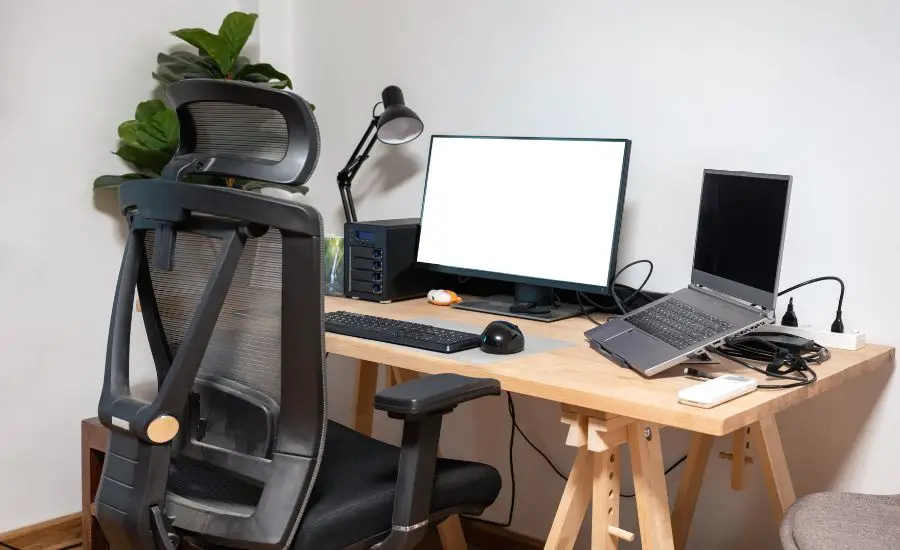
Frequently Asked Questions (FAQs):
If you have any questions left, read the information below.
How big a desk do you need for 2 monitors?
When considering a dual monitor setup, it’s important to assess the size of the desk needed to accommodate two monitors on a small desk.
While a small desk may present space limitations, it is still possible to create a functional dual-monitor workstation.
However, it’s crucial to ensure that the size of the desk meets the minimum requirements to support the setup.
To accommodate two monitors, the size of the desk will depend on various factors such as the monitor size, bezels, monitor stands, and desired workspace for two monitor setups.
However, a desk with a width of at least 50 inches (127 cm) and a depth of 24 inches (60 cm) should provide enough space for two monitors and other accessories.
If you’re determined to fit two monitors on a small desk, consider using a monitor stand or arm to free up additional desk space.
These accessories allow you to position the monitors at optimal heights and angles while maximizing the available workspace.
Is a 40 inch desk big enough for two monitors?
For those working with a small desk, it might be more practical to position one monitor horizontally and the other vertically.
This arrangement maximizes the available space and allows for efficient multitasking. A minimum desk size of around 40 inches (102 cm) in width and 20 inches (51 cm) in depth is typically recommended for this configuration.
A 40-inch desk may be too small for comfortably fitting two monitors on a small desk, especially if they are larger. It is recommended to opt for a wider desk to ensure plenty of space for the two monitors and a comfortable working area.
It’s important to note that utilizing one monitor on a small desk may be a more viable option in such cases. This setup allows for a more ergonomic workstation, providing ample desk space for other essential items and promoting a clutter-free environment.
What type of desk is best for dual monitors?
When it comes to dual monitors, a desk that offers sufficient width and depth, along with adjustable features for ergonomics, is ideal. Rectangular or L-shaped desks are popular choices as they provide ample desk space and flexibility in positioning two monitors.
What size desk do I need for 27 inch monitor?
For a 27-inch monitor, a desk with a width of around 32 inches (81 cm) and a depth of 16-20 inches (41-51 cm) should be suitable. However, it is always beneficial to choose a slightly larger desk to provide extra space for accessories and a comfortable working environment.
Conclusion
Selecting the right desk size for a dual monitor setup is crucial for creating efficient workspace. By considering factors such as monitor size, ergonomics, available space, desk layout, monitor stand, monitor arm, additional equipment, and future expandability, you can choose a desk that suits your needs.
When setting up a dual monitor desk setup, selecting the desk size is crucial for creating a functional workspace.
By carefully assessing your needs and considering the recommended monitor size, you can create an optimal workstation that enhances productivity and comfort.
Whether you opt for a standing desk, corner desk, or traditional computer desk, ensure that it provides space for your dual monitors or placing monitor vertically, accessories, and comfortable working distances.

